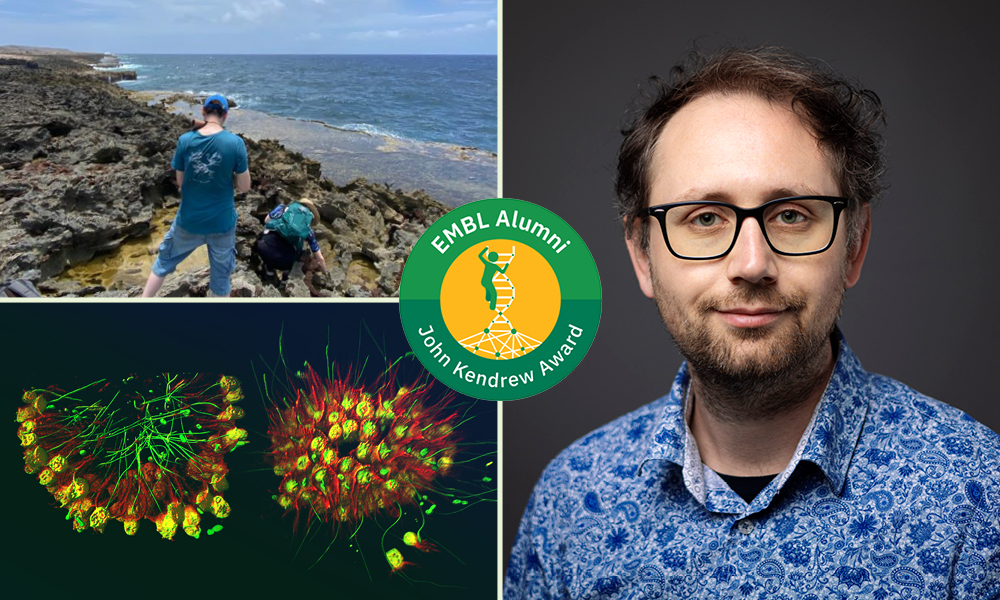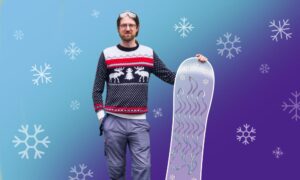
Merging passion, collaboration, and serendipity
EMBL alumnus Thibaut Brunet, recipient of the 2024 John Kendrew Young Scientist Award, shares his scientific journey – from a childhood passion for nature to the discovery of a new species of choanoflagellate.

Thibaut Brunet would never have imagined that a spontaneous field trip to Curaçao, an idyllic island in the Caribbean Sea, would ultimately lead to discovering a new single-celled organism that jump-started his scientific career. But that is exactly what happened.
Now a group leader at the Department of Cell Biology and Infection at the Institut Pasteur in Paris, Thibaut Brunet completed his PhD in the Arendt Group at EMBL Heidelberg, followed by a postdoc fellowship at UC Berkeley. During this time he embarked on the fortuitous field trip to Curaçao, where he did indeed discover a new species of choanoflagellate – a type of free-living unicellular microorganism. This would be a career-shaping moment for his research.
Recently, he received the 2024 John Kendrew Young Scientist Award for his work in the field of evolution and development. Here, he shares his scientific journey – from a childhood passion for nature to his first groundbreaking discovery – along with his views on open science and AI.
What sparked your interest in science originally?
I grew up in a French city named Dijon, in a suburb of subsidised residential mass housing, so unlike many biologists, I was not surrounded by nature while growing up. But I was lucky that my family, although not well-off, was very intellectually curious, and as a kid I developed a passion for dinosaurs that my family encouraged. This became an interest in nature in general and biological evolution in particular, which I nurtured by semi-obsessively looking for any form of popular science I could find around these topics.
As a kid, I was not really into biology classes at school, which were often descriptive and focused on activities I was not good at, such as drawing – so having access to high-quality popular science was really important. I reconciled with formal education later in life, when I moved to Paris at age 18 to start “classes préparatoires” (a type of undergrad training in France) and later to study at the Ecole Normale Supérieure. The biology classes in prépa were demanding but very stimulating. We also had maths and physics classes which made me discover and really appreciate mathematical reasoning, to the point that it made me sometimes regret I didn’t become a mathematician. More importantly, overall, that experience gave me a strong feeling of having finally found my place in life as well as my ‘people’ and cemented my desire to become a biologist.
Can you tell us about the time you discovered a new species of choanoflagellate in the Caribbean Sea? What was the significance of this discovery?
We discovered a species of choanoflagellate we named Choanoeca flexa that displays a unique multicellular morphology and collective behaviour. It has been the focus of about half of my research since then. Choanoflagellates are aquatic microorganisms that are usually single-celled and happen to be the closest living relatives to animals in the tree of life. Thus, they offer insight into how bigger, multicellular animals evolved over time. Each cell is smaller than a grain of sand and looks like a tiny sphere with a single tail-like flagellum – a hair-like strand protruding from the sphere.
C. flexa was an accidental finding. As a postdoc at UC Berkeley, I was funded by an HFSP fellowship that provided some research money I could spend freely. So out of curiosity, I decided to join a field trip to Curaçao organised by colleagues to learn fieldwork and protist isolation. We ended up finding a very rich, diverse choanoflagellate community in oceanic pools filled by the waves on the rocky coast of Curaçao, including at least three new species.
One of them, C. flexa, formed large cup-shaped colonies of hundreds of cells which could reach half a millimetre in diameter, meaning the largest ones were visible to the naked eye. One remarkable aspect of these colonies is that they display fast changes in shape: much like a flock of birds in a murmuration that shifts its collective shape, C. flexa colonies respond to environmental stimuli like light, touch, water flow, and certain chemicals, by inverting their collective cuplike outline so that it points in the opposite direction.
I remember the first time we saw it as if it was yesterday. It was just mesmerising – a colony of microbes that was completely restless, moving around, shape-shifting and exploring the world almost like an animal, giving off an eerie sense of agency. We were instantly struck by it and decided to put our respective current projects on hold to study this. We also thought there might be some potential evolutionary importance to this finding: since choanoflagellates are the closest living relatives to animals in the tree of life, C. flexa could give us a sense of what the ancient ancestors of animals looked like when they first started tinkering with multicellularity (although we now think C. flexa and animals most likely evolved multicellularity independently of each other).
This became a great collaboration with two outstanding PhD students, Ben Larson and Tess Linden. These two amazingly smart, thoughtful, humble, and kind individuals also became my lifelong friends and another demonstration that science is also about finding your people. The study required a lot of hard work, but also some luck – not only for the initial observation, but also in the fact that we could culture the species in the lab, which was a necessary prerequisite to study its biology in deep detail. Since then, we have published three research papers on the biology of this species, but I still sometimes feel we have only scratched the surface.
Which research findings from your lab so far are you most excited about?
I tend to get excited about a lot of things! Lately, we put out a preprint in which we described the multicellular development of C. flexa. Classically, eukaryotic multicellularity can develop in one of two ways: independent free-living cells coming together, or a mother cell dividing many, many times to give rise to a bunch of daughter cells. It’s one or the other, but not both – in fact, there are evolutionary theory arguments as to why you should diverge toward one or the other extreme, but not be in between.
It turns out that, unexpectedly, C. flexa breaks the rule by being able to develop equally well in one or the other way, or by using a combination of both methods. We think this is due to the fact that it develops in a very unusual and unstable environment, in which this intermediate mode of development is selected for. To test this, we had to go back to the field and test lab-born hypotheses in situ. What I really enjoyed here was the dialogue between field biology and cell biology in a lab, which was an unusual experience for me, as I have been trained more as a classical “lab-based” cell and developmental biologist.
How did your time at EMBL influence your scientific journey?
Science is a little bit of a schizophrenic activity (in the colloquial, not clinical, sense of the term)! It asks you to dream up hypotheses, but also to be pitiless in culling them if they are contradicted by empirical data. What I learned from EMBL is a form of boldness on both sides of that dialectic – don’t be afraid to dream up bold ideas, but be ready to scrutinise them with the highest standards of rigour, and to potentially have to throw them away if they don’t pass the test. EMBL was a great place to absorb that mindset as a PhD student, because we were surrounded by scientists who were remarkably creative but also their own worst critics – one of which was my PhD advisor, Detlev Arendt. From him, I learned a lot about how to be both very creative and very rigorous.
It also made a difference that we had access to cutting-edge equipment and to world-class experts in almost any technique, so we had huge experimental power to test hypotheses. I really see the EMBL community as embodying that spirit, and I have been trying to do my small part to spread it since then.
What research questions are you working on currently and what’s next for your lab?
We have a big interest in cell shape – both in the mechanisms of cellular morphogenesis, the process in which cell shape develops, but also in how it evolves. Of course this is a big question we cannot address fully, so we focus for now on the evolution and development of specific cell structures, such as the collar complex of choanoflagellates. We also have collaborations with other scientists with whom we explore exciting aspects of choano cell biology – including several at EMBL, such as Gautam Dey for mitosis, Alba Diz-Muñoz for cell surface mechanics, and Yannick Schwab, who has provided great support to our forays in cryo-electron microscopy.
How do you see the scientific landscape changing in the coming years, and what responsibility do you believe scientists bear towards society at large?
Technology is changing everything. On one hand, the internet allows near-instant worldwide dissemination of knowledge, so open science and transparent science are not just morally laudable aspirations, but a pragmatic necessity if we want science to progress as well and as fast as it can. We will have to negotiate a changing role for journals, which many people think will become curators of content first published in preprints, and I think that would not be a bad outcome.
On the other hand, it is obvious that AI has changed many things, and will continue to change things enormously. It’s hard to predict exactly how: it can be tempting to consider current advanced AI systems such as large language models (LLMs) and make predictions based on what these can and can’t do, but it’s likely that AI systems 20 or 30 years from now will be qualitatively different, just as LLMs are qualitatively different from anything that existed 10 years ago.
I think a key responsibility for scientists will be to make sure that AI systems continue to serve humanity, help people understand the world, support human flourishing, and protect our natural environment. A large part of this will be to make sure AI remains controllable even if/when it reaches some level of autonomy – the problem known as the ‘AI alignment’. This is already a well-known issue, but I expect it to become more prominent in the coming years.
What does EMBL mean to you personally and professionally?
I talked earlier about the importance of finding your people, and EMBL is definitely one of the places I found my people. There is a sense in which EMBL is a place, but in perhaps an even more important sense, it is a spirit and a community that nurtures important values: intellectual honesty, passion, persistence, creativity, rigour. In that sense, one never fully leaves EMBL. I am grateful to be part of it.
Find out more
Click here to watch Thibaut’s presentation at the 2024 EMBL Alumni Awards Ceremony on 5 July 2024.
Nominations and applications for the 2025 John Kendrew and Lennart Philipson Awards and the 2025 Kafatos Lecture are now open. Please click here to find out more and submit a nomination or application.
Related links
- Thibaut Brunet's research group's website at Institut Pasteur
- Preprint "Mixed clonal-aggregative multicellularity entrained by extreme salinity fluctuations in a close relative of animals" on bioRxiv
- Thibaut's presentation at the 2024 EMBL Alumni Awards Ceremony on 5 July 2024
- EMBL Alumni Relations Awards page


